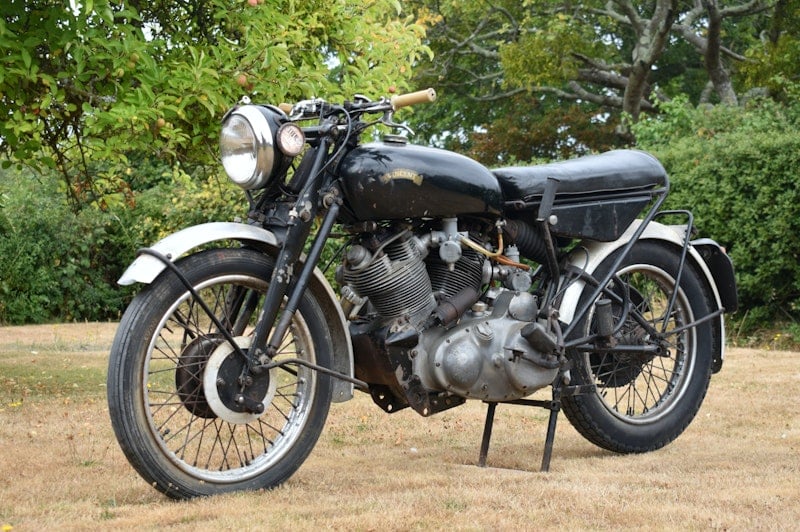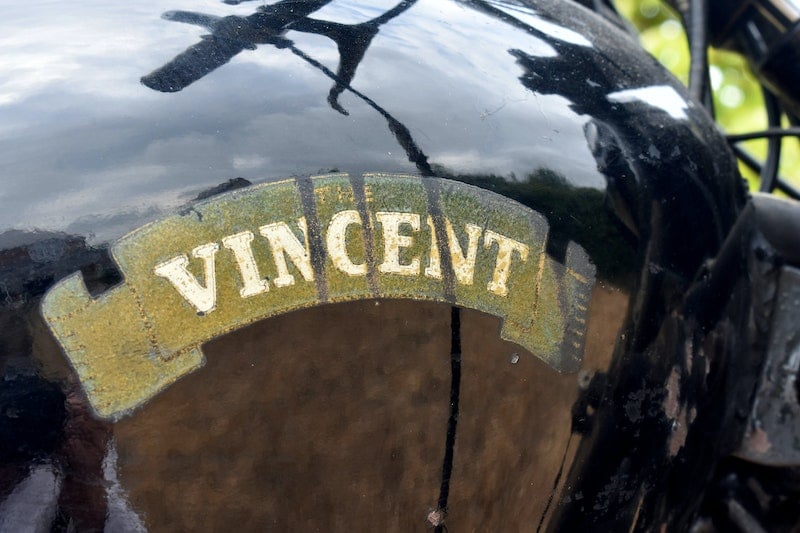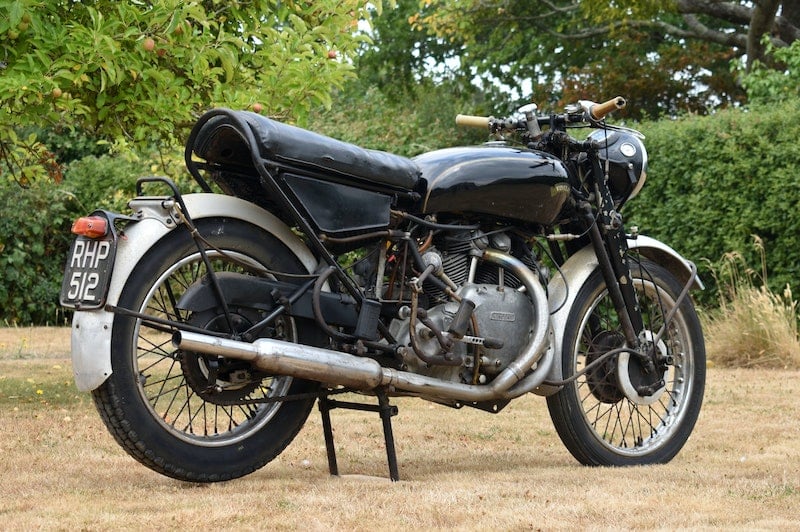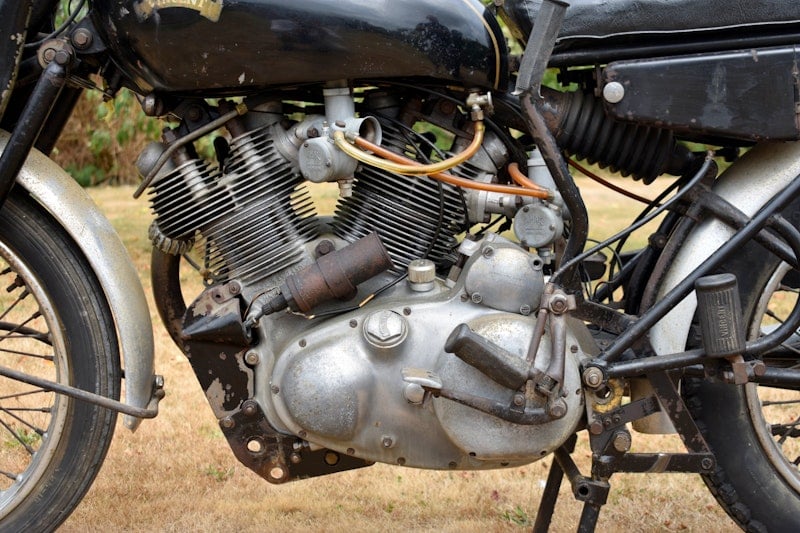1955 Vincent Rapide Series D
Highlights
- Remarkable unrestored survivor in its completely original factory finish
- Ownership history back to 1961
- Off the road and never seen publicly since 1967
- Requires light mechanical restoration
The Appeal
But the previous year, Phil Vincent, who had been building motorcycles since 1928, developed what might well have been the world’s finest single-cylinder motorcycle, the mighty 500cc Comet.
Running like Archimedes to Phil Vincent to seek approval for his idea, the big man himself received it with the same delighted enthusiasm. So it was that in 1936 the 1000cc Rapide became a reality, and was eyeing up Brough Superior’s crown.
Brough, of course, did not survive beyond the outbreak of war. Vincent, on the other hand, returned to production and survived until 1955, when low-volume, high-quality machines could no longer compete with cheaper mass-produced products.
The Rapide survived until the very end, with its final and most refined incarnation, the Series D, appearing in 1954. With such a short production run lasting just only a little over 12 months, only 528 Series Ds were built, of which 233 featured a distinctive cowling.
This is something rarer still—a totally original, unrestored Rapide still sporting the same coat of paint and all the fittings that were applied at the Vincent works in Stevenage in 1955.
With a credible 15,000 miles up to 1967 and ownership traceable to 1961, it is one of the most historic survivors and deserves an owner who will administer a sympathetic mechanical restoration but otherwise preserve its unique and important finish.
In any collection of Vincent road bikes, this would make the perfect centrepiece, even more so than a restored Black Shadow.
The History and Paperwork
- Originally registered in Coventry on May 16th 1955
- Earliest recorded owner a Mr. Francis James Flanagan of Coventry in 1961
- Ownership passed to Mr. Richard Gibbens of Sutton Coldfield in 1967, after which the bike was garaged after a fuel pipe split, covered in a protective coat of Duck Oil and never used again
- Recovered from its garage in 2016 by a motorcycle dealer, the Vincent was sold to an Isle of Wight collector with over 50 motorcycles
- The collector is now dispersing his collection to fund building work, but has saved his three Vincents until last
- Paperwork with the bike includes the current V5, registration documents from the DVLA, a replacement buff logbook from 1961 and its last MoT certificate issued in 1966
The Condition
- Paint and all other fittings believed to be completely original
- Patinated but otherwise sound in virtually every respect
- There probably isn’t another Series D like it
Anyone with an appreciation for the history of the Vincent company and the craftsmanship of its workers will revere the fact that this bike has survived wearing everything as it was applied at the works, and those who are less interested in the minutiae just love the characterful appearance afforded it by its patina.
Obviously, there is a certain fragility to the finish in places, such as where the paint has cracked and flaked from the front of the fuel tank, but they will not be a barrier to riding and enjoying the bike, provided it is stored well and suitably maintained in the meantime.
Either way, it is important that the seat is preserved rather than restored, and we would recommend consulting a preservation specialist to assist if necessary.
We’d be tempted to mount the old tyres on our garage wall as a keepsake, though…
The Mechanics
- All matching numbers
- All mechanical components believed to be original
- The Rapide ran in 2016 but now requires some mechanical restoration
When the bike was recovered in 2016, the gentleman who sold it to the vendor drained the oil, refilled it with a detergent oil, supplied it with a new battery and fuel and proceeded to get it running and ride it around a private estate.
For obvious reasons, we would strongly recommend overhauling the brakes before using the Rapide on the road, but this is certainly not in a bad way for a bike which hasn’t been used for 55 years, and it should be realistic to have this bike on the road in just a few weeks if you don’t mind spending some evenings and weekends on it.
Summary
As one of only 295 uncowled Series Ds, it is very rare but of even greater importance than its rarity is its all-original, unrestored condition.
In this condition, you could park next to a restored Black Shadow and the Rapide will probably generate much more interest and admiration.
Notice to bidders
- Year 1955
- Make Vincent
- Model Rapide Series D
- Colour Black
- Odometer 15,069 Miles
- Engine size 998
- Seller Type Private
- Town Lymington
- Location Hampshire
- Country United Kingdom
- jo•••• £30,500 10/08/22
- da•••• £30,000 10/08/22
- Ge•••• £29,500 10/08/22
- da•••• £28,500 10/08/22
- Ge•••• £27,500 10/08/22
- da•••• £25,500 10/08/22
- bi•••• £25,000 10/08/22
- se•••• £22,500 10/08/22
- An•••• £21,750 09/08/22
- se•••• £21,500 09/08/22
The Gallery

About Max Bids
The max bid process allows you to bid without any hassle.
Enter your maximum bid and we will then bid on your behalf to ensure you're the highest bidder - just enough to keep you in the lead and only up until your maximum.
Anti-sniping
Car & Classic prevent auction snipers from bidding in the last seconds to win an auction.
Auctions are extended by 3 minutes if anyone bids within the last 2 minutes to allow other bidders to react and counter-bid.
Auto-bidding increments
- If your maximum bid is equal to or below the reserve price, your maximum bid will be applied in full if you are the highest bidder.
- If you are the highest bidder and place a maximum bid above the reserve, we will automatically put in the reserve as your first bid.
-
- Once the reserve has been met, Car & Classic will make sure you are the highest bidder using only the bidding increments stated below.
- We will keep you in the lead up until your maximum bid OR the increment closest to your maximum bid, providing your maximum bid is enough to cover the increment value.
| Bid Amount | Increment |
|---|---|
| £0 to £9,999 | £100.00 |
| £10,000 to £49,999 | £250.00 |
| £50,000 to £99,999 | £500.00 |
| £100,000 + | £1,000.00 |
Automatically outbid immediately
When you place a max bid and are outbid immediately that means that another bidder has placed a max bid limit which is higher than yours.
You can bid again and we will use our automatic bid system to try and get you as the highest bidder.
Matching max bids
When there are two max bids of the same value, the one placed first remains the lead bidder.
Pre-authorisation
We may hold a pre-authorisation charge on your card until the end of the auction when the hold will be cancelled. If you win, we'll take a security deposit which counts towards the payment for the vehicle and isn't any extra cost to you.
What are pre-bids?
A pre-bid means you're able to place a bid before the official start of the auction.
You will be notified whether or not you are the highest bidder when the auction starts.
Problem with your bid
Bids are contractually binding. To help protect you, we have some rules in place if we think it's been mistyped. Please check and amend what you have entered.




















































































































































































































